Programm

NISS: Network Interaction Sound Sniffer
Sergio Lecuona Fornes (ES)
NISS is a sound installation that reacts to the exchange of data carried out through a WiFi network. The soundscape produced by eight reception bells and synthesized sounds makes the hidden digital dialogues between devices perceptible.
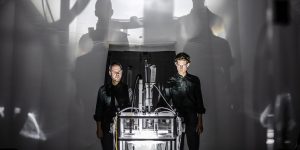
Polar Force
Speak Percussion, Philip Samartzis (AU), Eugene Ughetti (AU)
Polar Force is a phenomenological investigation of the windiest, coldest, and driest continent on earth: Antarctica. During the one-hour work, vivid multichannel Antarctic field recordings of wind, water, and ice are combined with new instruments, sampled in a live performance and a choreographed artistic “lecture” undertaken by two performers reminiscent of scientists in a remote polar field station. The immersive live performance merges the art-science-tech to comment on geopolitical issues and the climate crisis.
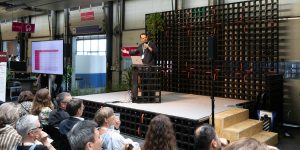
Practices & Impacts of STARTS Collaborations
FRI 6.9. | 10:00 – 12:00 Practices and impacts of interdisciplinary approaches will be discussed through innovative projects, with a special focus on the link between artificial intelligence and music.
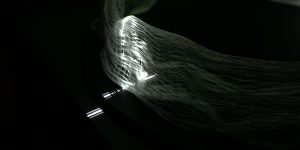
CROSSING #03
Akinori Goto (JP)
In this work, when the light from the slit is projected onto the sculpted object, the movement of walking people is revealed. By reorganizing the diverse people filmed by the artist onto a single time axis, something akin to a community moving toward a purpose takes shape. Within this is a movement that differs from physical movement.

Chilean Artist Talks
This year, for the second time, the Ministerio de las Culturas, las Artes y el Patrimonio and the Ministerio de Relaciones Exteriores | Gobierno de Chile and Ars Electronica Linz collaborated in asking artists, scientists, designers, researchers, entrepreneurs and social activists from Chile or with a Chilean background to participate in the Ars Electronica Festival and discuss the current developments and tendencies in the Chilean media art scene.
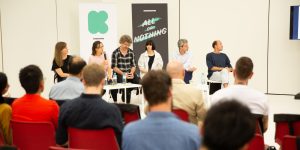
Gallery Spaces Panel V: Artists & scientists – Exploring new forms of collaboration (Scientist in Residence Program)
Just as artists today are increasingly interested in science and technology, scientists and technologists are turning to the arts as a source of new perspectives and tools for communication. This trend requires new initiatives to establish better links between the worlds of art and science, as well as between cultural and research institutions. Through its Art&D labs, Gluon supports artist residencies in laboratories of companies, research institutes and universities. Through its Scientists in Residence programme, it encourages artists to open their studios to scientists and technologists. On the basis of their experiences in these programmes, the scientists of this panel will reflect on the following questions: To what extent can these interdisciplinary collaborations stimulate innovative ideas and projects of social relevance? What challenges do scientists have to face in working together with artists? And how can organizations help them achieve meaningful exchanges?
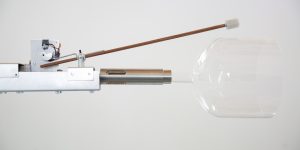
Smart.ing Bodies
Evelina Rajca (PL)
Sand, or to put it more precisely high-purity silicon dioxide particles, is the essential raw material from which we make concrete, glass, fiberoptic cables, computer chips, and other high-tech hardware. The installation Smart.ing Bodies features “glass instruments” made of quartz sand that Evelina Rajca collected from disappearing beaches and mountains around the world. The multisensory sound installation consists of those two glass resonators, sensors, motors, and an algorithmic composition created partly by AI learning processes. In order to keep on playing and to avoid a “resonance disaster” (the destruction of the glass or motor), the algorithmic program has to learn to conduct a variety of smart frequencies. What can be heard is the sound of sand, which is pure yet complex and ever-changing.
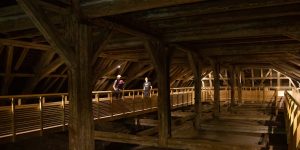
MANTRAcks and Sonic Fields: A VirtuAural Duology Part 1 – untitled #352
Francisco López (ES)
Industry and nature are the opposing starting points for this long-term sound meta-piece, which originally consisted of two parts. The ten-channel audio installation untitled #352 was specially adapted for the attic of the Ursulinenkirche: Complex layers of sound, recorded in Fontenay-sous-Bois near Paris, develop further and are distilled into expansive electronic mantras (“MANTRAcks”).
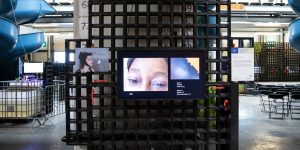
VOIGHT-KAMPFF
Yonlay Cabrera (CU)
The project is based on a procedure for measuring the involuntary ocular changes that happen in a group of people, determined according to categories that correspond with the “Ideological Apparatus of State” (Louis Althusser) used by the Cuban Government. The people are submitted to questions that “stress-test” the normal values in order to determine to what extent they reproduce the ideal behaviors internalized by the ideological apparatus.

Insect a new media
Fernando Asensio (ES), José Luis Cuenca (EC), Alejandra Florez (CO), Silvia García (ES), Noelia Medina (ES), Jordi Sos (ES)
This interactive installation proposes a symbiosis between obsolete technology and natural environment, as an approach to a dystopian future world. A group of sculptural objects composed of plants and technological waste, a multi-screen projection device, a technological codex and a descriptive catalogue make up this undead multimedia project.


